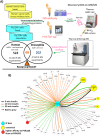A Cross-Species Study of PI3K Protein-Protein Interactions Reveals the Direct Interaction of P85 and SHP2
- PMID: 26839216
- PMCID: PMC4738311
- DOI: 10.1038/srep20471
A Cross-Species Study of PI3K Protein-Protein Interactions Reveals the Direct Interaction of P85 and SHP2
Abstract
Using a series of immunoprecipitation (IP)-tandem mass spectrometry (LC-MS/MS) experiments and reciprocal BLAST, we conducted a fly-human cross-species comparison of the phosphoinositide-3-kinase (PI3K) interactome in a drosophila S2R+ cell line and several NSCLC and human multiple myeloma cell lines to identify conserved interacting proteins to PI3K, a critical signaling regulator of the AKT pathway. Using H929 human cancer cells and drosophila S2R+ cells, our data revealed an unexpected direct binding of Corkscrew, the drosophila ortholog of the non-receptor protein tyrosine phosphatase type II (SHP2) to the Pi3k21B (p60) regulatory subunit of PI3K (p50/p85 human ortholog) but no association with Pi3k92e, the human ortholog of the p110 catalytic subunit. The p85-SHP2 association was validated in human cell lines, and formed a ternary regulatory complex with GRB2-associated-binding protein 2 (GAB2). Validation experiments with knockdown of GAB2 and Far-Western blots proved the direct interaction of SHP2 with p85, independent of adaptor proteins and transfected FLAG-p85 provided evidence that SHP2 binding on p85 occurred on the SH2 domains. A disruption of the SHP2-p85 complex took place after insulin/IGF1 stimulation or imatinib treatment, suggesting that the direct SHP2-p85 interaction was both independent of AKT activation and positively regulates the ERK signaling pathway.
Figures





Similar articles
-
Interleukin-3 induces association of the protein-tyrosine phosphatase SHP2 and phosphatidylinositol 3-kinase with a 100-kDa tyrosine-phosphorylated protein in hemopoietic cells.J Biol Chem. 1997 Nov 14;272(46):29281-9. doi: 10.1074/jbc.272.46.29281. J Biol Chem. 1997. PMID: 9361008
-
Detection of a rare BCR-ABL tyrosine kinase fusion protein in H929 multiple myeloma cells using immunoprecipitation (IP)-tandem mass spectrometry (MS/MS).Proc Natl Acad Sci U S A. 2012 Oct 2;109(40):16190-5. doi: 10.1073/pnas.1212759109. Epub 2012 Sep 17. Proc Natl Acad Sci U S A. 2012. PMID: 22988110 Free PMC article.
-
Activated STAT5 proteins induce activation of the PI 3-kinase/Akt and Ras/MAPK pathways via the Gab2 scaffolding adapter.Biochem J. 2005 Aug 15;390(Pt 1):359-66. doi: 10.1042/BJ20041523. Biochem J. 2005. PMID: 15833084 Free PMC article.
-
Structure and function of Gab2 and its role in cancer (Review).Mol Med Rep. 2015 Sep;12(3):4007-4014. doi: 10.3892/mmr.2015.3951. Epub 2015 Jun 17. Mol Med Rep. 2015. PMID: 26095858 Free PMC article. Review.
-
Class IA PI3K regulatory subunits: p110-independent roles and structures.Biochem Soc Trans. 2020 Aug 28;48(4):1397-1417. doi: 10.1042/BST20190845. Biochem Soc Trans. 2020. PMID: 32677674 Free PMC article. Review.
Cited by
-
Unique properties of PTEN-L contribute to neuroprotection in response to ischemic-like stress.Sci Rep. 2019 Feb 28;9(1):3183. doi: 10.1038/s41598-019-39438-1. Sci Rep. 2019. PMID: 30816308 Free PMC article.
-
Targeting PI3K/Akt in Cerebral Ischemia Reperfusion Injury Alleviation: From Signaling Networks to Targeted Therapy.Mol Neurobiol. 2024 Oct;61(10):7930-7949. doi: 10.1007/s12035-024-04039-1. Epub 2024 Mar 5. Mol Neurobiol. 2024. PMID: 38441860 Review.
-
Akt1 and dCIZ1 promote cell survival from apoptotic caspase activation during regeneration and oncogenic overgrowth.Nat Commun. 2020 Nov 12;11(1):5726. doi: 10.1038/s41467-020-19068-2. Nat Commun. 2020. PMID: 33184261 Free PMC article.
-
Isoform-specific activities of the regulatory subunits of phosphatidylinositol 3-kinases - potentially novel therapeutic targets.Expert Opin Ther Targets. 2018 Oct;22(10):869-877. doi: 10.1080/14728222.2018.1522302. Epub 2018 Sep 24. Expert Opin Ther Targets. 2018. PMID: 30205700 Free PMC article. Review.
-
Shp2 regulates migratory behavior and response to EGFR-TKIs through ERK1/2 pathway activation in non-small cell lung cancer cells.Oncotarget. 2017 Aug 14;8(53):91123-91133. doi: 10.18632/oncotarget.20249. eCollection 2017 Oct 31. Oncotarget. 2017. PMID: 29207630 Free PMC article.
References
Publication types
MeSH terms
Substances
Grants and funding
- R01GM041890/GM/NIGMS NIH HHS/United States
- 5P30CA006516/CA/NCI NIH HHS/United States
- R01 HL114775/HL/NHLBI NIH HHS/United States
- 5P01CA120964/CA/NCI NIH HHS/United States
- P01 CA120964/CA/NCI NIH HHS/United States
- R01HL114775/HL/NHLBI NIH HHS/United States
- R01 GM041890/GM/NIGMS NIH HHS/United States
- Howard Hughes Medical Institute/United States
- R01HL102368/HL/NHLBI NIH HHS/United States
- R01 HL102368/HL/NHLBI NIH HHS/United States
- S10 OD010612/OD/NIH HHS/United States
- P30 CA006516/CA/NCI NIH HHS/United States
- 1S10OD010612/OD/NIH HHS/United States
LinkOut - more resources
Full Text Sources
Other Literature Sources
Molecular Biology Databases
Research Materials
Miscellaneous

